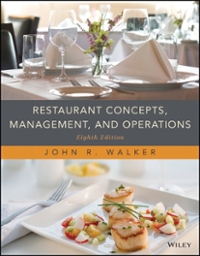Question
1) Which is the best example of disruptive innovation? Select one: a. Apple introduces the iPhone. b. General Electric sells its nuclear power plants in
1) Which is the best example of "disruptive innovation?"
Select one:
a. Apple introduces the iPhone.
b. General Electric sells its nuclear power plants in Japan.
c. ING Bank increases savings rates when all other banks reduce their rates.
d. General Biscuit discontinues its oldest brand of crackers.
2) In the strategic choice process, what contributes to greater feasibility for a firm?
Select one:
a. A favorable change in government regulations.
b. The "fit" of strategic options.
c. Positive cash flow every month.
d. Vertical integration's costs and benefits.
3) What is the driving force in globalization?
Select one:
a. Population
b. Technology
c. Currency
d. Culture
4) There is a large European multinational firm that sells coffee to consumers. They buy coffee from around the world, process it, and distribute it to stores around the world. The firm is considering buying a tea company from India. What kind of diversification would this be?
Select one:
a. Related
b. Unrelated
c. Conglomerated
d. Amalgamated
5) If country A can produce 10 tons of gold and 21 tons of silver and country B can produce 10 tons of gold and 10 tons of silver, which country has the absolute advantage in which goods?
Select one:
a. Country A in both goods.
b. Country B in both goods.
c. Country A in silver.
d. Country B in silver.
6) What is another name for a niche strategy?
Select one:
a. Vertical
b. Focused generic
c. Concentric
d. Oligopolistic
7) There is a small, family-owned store that sells food and household goods in a small town. The owners have good relations with the community, especially with local farmers who supply much of the food. The farmers aren't organized into a cooperative or union, and the store deals with each individually. Based on this scenario, where would the firm's good relations with the community and farmers be placed in a SWOT?
Select one:
a. Strengths
b. Weaknesses
c. Opportunities
d. Threats
8) A beverage company decides to differentiate its cola to appeal to a niche market. From a production viewpoint, what is a risk of this strategy?
Select one:
a. Consumers may not like the taste of the niche cola.
b. The government may require approvals for the new product.
c. Standard cost for the niche product may be significantly higher.
d. The economy may turn sour and dampen sales.
9) What kind of strategy best describes this statement: The manufacturing division will have less than five defects a day over the next month.
Select one:
a. Values-driven
b. Concentric
c. Functional
d. Cooperative
10) There is a large European multinational firm that sells coffee to consumers. They buy coffee from around the world, process it, and distribute it to stores around the world. The firm attempts to buy the coffee beans at the lowest possible cost. Suppose there is a new excise tax on raw coffee beans. In a PEST, where would this be classified?
Select one:
a. Political
b. Economic
c. Social
d. Technological
11) Concerning a SWOT, which statement is true?
Select one:
a. Strengths and Opportunities are internal.
b. An Opportunity can also be a Threat.
c. The analysis is always organized as a chart.
d. Only the highest executives should develop the SWOT because only they understand the
strategic direction of the organization.
12) Which strategy usually focuses on reducing manufacturing costs?
Select one:
a. Liquidation
b. Turnaround
c. Captive company
d. Sell out
13) Firm A has a marginal cost of $3 and average cost of $4. Firm B has a marginal cost of $2.5 and average cost of $4.75. Firm C has a marginal cost of $2 and average cost of $5. Firm D has a marginal cost of $3.50 and average cost of $2.75. According to Porter's "generic strategies," which firm exhibits cost leadership?
Select one:
a. Firm A
b. Firm B
c. Firm C
d. Firm D
14) How do cell phone manufactures increase their competitive advantage?
Select one:
a. They offer unique features and introduce new models quickly.
b. They are located in high-wage countries.
c. They produce limited quantities.
d. They compete against national phone companies.
Step by Step Solution
There are 3 Steps involved in it
Step: 1

Get Instant Access to Expert-Tailored Solutions
See step-by-step solutions with expert insights and AI powered tools for academic success
Step: 2

Step: 3

Ace Your Homework with AI
Get the answers you need in no time with our AI-driven, step-by-step assistance
Get Started


